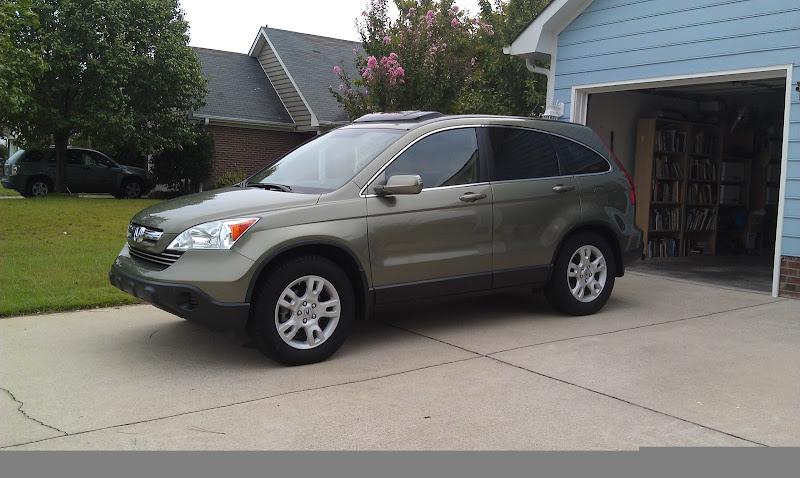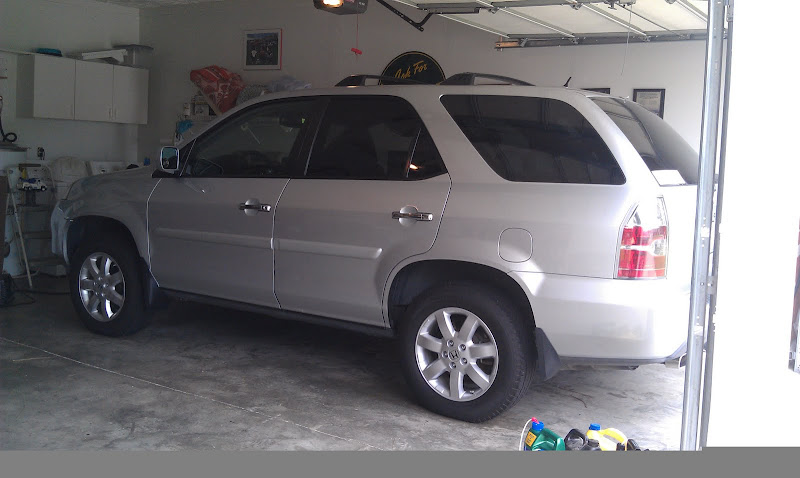I'm one who is rather particular about tires, and would rather test-drive a set before I buy. One rarely gets that opportunity in the tire market, but I have a unique situation in that both of my vehicles have nearly the exact same tire size, and in this particular tire make and model, the difference in actual size is even smaller than the nominal size would represent.
2005 Acura MDX: P235/65R17 Michelin Cross Terrain. OEM on this very vehicle.
2008 Honda CRV: P225/65R17 Michelin Cross Terrain. OEM on the Ford Escape with the 17" tire option.
The actual dimensions (from Michelin's website) are extremely close. The Section Width | Diameter | Revs/Mile | Weight are listed for each:
P225/65R17: 9" on 6.5" | 28.5" | 730 | 29.23 lbs.
P235/65R17: 9" on 6.5" | 28.9" | 726 | 28.92 lbs.
You can see that the section width is identical, diameter and revs/mile are as close as it gets for being two different sizes, and the weights are also nearly identical. Curiously, the larger tire being slightly lighter. Both of my vehicles have 6.5" wide wheels with identical offsets and nearly identical weight. The MDX wheel may be a touch heavier; it measured 54 pounds on the bathroom scale with the tire (wheel: 25 lbs). The CRV's wheel/tire weighed 53.5 lbs (wheel: 24 lbs).
I swapped these across today because the Cross Terrains on the MDX felt so much nicer than the ones on the CRV, and I wanted to find out how much of that difference was the vehicle and how much was the in the tire itself. As it turns out, I think it's mostly in the tire. I will compare the "Acura" tire with the "Ford" tire, as those are the OEM customers for each of these. I also adjusted the air pressure to match each respective vehicle (MDX: 32 psi; CRV: 30 psi) to make sure I was comparing apples to apples. The tread depth on the Acura tires here is 9-10/32" and on the Ford tires, about 6-7/32".
When I mounted the Acura tire on the CRV, I immediately noticed a decrease in rolling resistance. It seems to roll out of the garage much easier and seems to roll around parking lots easier with no gas or brake use. I also perceived a moderate difference in steering effort. The Acura tires felt very light on their feet. The Acura tires seem to require less slip angle before they generate cornering force. I don't know if that's possible with the only difference being the tires themselves, but that's what it seems like. The opposite effect was noted in the MDX: with the Ford tires mounted, you really had to saw the wheel to get it to generate some lateral traction at higher speeds.
As far as ride, there seems to be a clear advantage to the larger Acura tires. The Ford tires have a sharper impact feel than the Acura tires, but the Ford tires also have a squirmier feel as well. I didn't really notice that in the CRV much, but when I installed the Acura tires on it, a slight increase in stability was felt. The larger difference was the Ford tires on the MDX: I felt a moderate decrease in stability, and the vehicle felt wandery at speed.
This really illustrates to me how much an OEM-type tire's performance depends on the particular OEM customer in that size. Although the Ford and Acura tires are nearly identical in size (and absolutely identical in actual tread pattern), the rubber compound and internal construction appear to conspire to make dramatic differences in how the tires perform. The Acura version also appears to wear much better. Although I will confess that I don't know the number of miles that are on these Ford tires, I do know that it can't be more than 20,000 based on the DOT date on the tires and the miles on this car at the time. I suppose it's possible that they were installed used, but given the meticulous service history of the car, I doubt it.
In short, I absolutely recommend the Michelin Cross Terrain in the P235/65R17 size. It's a quiet and capable tire that handles excellent and delivers good wear and excellent traction (I can also vouch for its excellent snow traction). However, I absolutely do not recommend this same tire in the P225/65R17 size. It doesn't have the stability (despite having much less tread depth in this case!) that the P235 version has, nor does it have the road manners. I believe it wears much faster as well.
I will leave them like this for a few more days, and probably swap back this next weekend. I like the look of the Acura's wheels on the CRV, and don't really care for the Honda's wheels on the MDX.


2005 Acura MDX: P235/65R17 Michelin Cross Terrain. OEM on this very vehicle.
2008 Honda CRV: P225/65R17 Michelin Cross Terrain. OEM on the Ford Escape with the 17" tire option.
The actual dimensions (from Michelin's website) are extremely close. The Section Width | Diameter | Revs/Mile | Weight are listed for each:
P225/65R17: 9" on 6.5" | 28.5" | 730 | 29.23 lbs.
P235/65R17: 9" on 6.5" | 28.9" | 726 | 28.92 lbs.
You can see that the section width is identical, diameter and revs/mile are as close as it gets for being two different sizes, and the weights are also nearly identical. Curiously, the larger tire being slightly lighter. Both of my vehicles have 6.5" wide wheels with identical offsets and nearly identical weight. The MDX wheel may be a touch heavier; it measured 54 pounds on the bathroom scale with the tire (wheel: 25 lbs). The CRV's wheel/tire weighed 53.5 lbs (wheel: 24 lbs).
I swapped these across today because the Cross Terrains on the MDX felt so much nicer than the ones on the CRV, and I wanted to find out how much of that difference was the vehicle and how much was the in the tire itself. As it turns out, I think it's mostly in the tire. I will compare the "Acura" tire with the "Ford" tire, as those are the OEM customers for each of these. I also adjusted the air pressure to match each respective vehicle (MDX: 32 psi; CRV: 30 psi) to make sure I was comparing apples to apples. The tread depth on the Acura tires here is 9-10/32" and on the Ford tires, about 6-7/32".
When I mounted the Acura tire on the CRV, I immediately noticed a decrease in rolling resistance. It seems to roll out of the garage much easier and seems to roll around parking lots easier with no gas or brake use. I also perceived a moderate difference in steering effort. The Acura tires felt very light on their feet. The Acura tires seem to require less slip angle before they generate cornering force. I don't know if that's possible with the only difference being the tires themselves, but that's what it seems like. The opposite effect was noted in the MDX: with the Ford tires mounted, you really had to saw the wheel to get it to generate some lateral traction at higher speeds.
As far as ride, there seems to be a clear advantage to the larger Acura tires. The Ford tires have a sharper impact feel than the Acura tires, but the Ford tires also have a squirmier feel as well. I didn't really notice that in the CRV much, but when I installed the Acura tires on it, a slight increase in stability was felt. The larger difference was the Ford tires on the MDX: I felt a moderate decrease in stability, and the vehicle felt wandery at speed.
This really illustrates to me how much an OEM-type tire's performance depends on the particular OEM customer in that size. Although the Ford and Acura tires are nearly identical in size (and absolutely identical in actual tread pattern), the rubber compound and internal construction appear to conspire to make dramatic differences in how the tires perform. The Acura version also appears to wear much better. Although I will confess that I don't know the number of miles that are on these Ford tires, I do know that it can't be more than 20,000 based on the DOT date on the tires and the miles on this car at the time. I suppose it's possible that they were installed used, but given the meticulous service history of the car, I doubt it.
In short, I absolutely recommend the Michelin Cross Terrain in the P235/65R17 size. It's a quiet and capable tire that handles excellent and delivers good wear and excellent traction (I can also vouch for its excellent snow traction). However, I absolutely do not recommend this same tire in the P225/65R17 size. It doesn't have the stability (despite having much less tread depth in this case!) that the P235 version has, nor does it have the road manners. I believe it wears much faster as well.
I will leave them like this for a few more days, and probably swap back this next weekend. I like the look of the Acura's wheels on the CRV, and don't really care for the Honda's wheels on the MDX.



